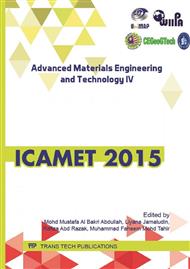[1]
Kanna V., Olson R. A. and Jennings H. M. (1998), Effect of shrinkage and moisture content on the physical characteristics of blended cement mortars, Cement and Concrete Research, 28, (1998), 1467-1477.
DOI: 10.1016/s0008-8846(98)00120-3
Google Scholar
[2]
Wenyan Z., Yukio H. b, Seung H. N., Drying shrinkage and microstructure characteristics of mortar incorporating ground granulated blast furnace slag and shrinkage reducing admixture, Construction and Building Materials, Volume 93 (2015), 267–277.
DOI: 10.1016/j.conbuildmat.2015.05.103
Google Scholar
[3]
Holt, Erika, Contribution of Mixture Design to Chemical and Autogeneous Shrinkage of Concrete at Early Ages, Cement and Concrete Research, vol 35 (2005), 464-472.
DOI: 10.1016/j.cemconres.2004.05.009
Google Scholar
[4]
Grasley, Z., Lange, D.A., D'Ambrosia, Matthew D. and Villalobos-Chapa and Salvador (2006). Relative Humidity in Concrete, Concrete International, (2006) 51-57.
Google Scholar
[5]
Ekaputri, J. J., Bongotchgetsakul, A., Ishida T., Maekawa, K., Internal Relative Humidity Measurement on Moisture Distribution of Mortar Considering Self-Dessication at Early Ages, JCI Annual Conference, 31 no 1 (2009) 643-648.
Google Scholar
[6]
Nawa, Toyoharu and Horita, Tomoaki, Autogeneous Shrinkage of High-Performance Concrete, Proceeding of the International Workshop on Microstructure and Durability to Predict Service Life of Concrete Structures, (2004), Japan.
Google Scholar
[7]
Ishida, T., Maekawa, K. and Kishi, T. Enhanced Modeling of Moisture Equilibrium and Transport in Cementitious Materials under Arbitrary Temperature and RH History,. Cement and Concrete Research, vol. 37 (2007), 565-578.
DOI: 10.1016/j.cemconres.2006.11.015
Google Scholar
[8]
Ishida T., Luan Y., Sagawa T., and Nawa T., Modeling of early age behavior of blast furnace slag concrete based on micro-physical properties, Cement and Concrete Research, 41 (2011) 1357–1367.
DOI: 10.1016/j.cemconres.2011.06.005
Google Scholar
[9]
Kumar, S., Kumar, R., Bandopadhyay A., Alex T.C., Kumar B. R., Das S.K. and Mehrotra, S.P. (2008).
Google Scholar
[10]
Roy D. M. and Idorn G. M. (1982). Hydration, structure, and properties of blast furnace slag cements, mortars and concrete,. ACI Journal, 444-457.
DOI: 10.14359/10919
Google Scholar
[11]
Lim S.N. and Wee T.H. (2000). Autogeneous shrinkage of ground-granulated blast-furnace slag concrete,. ACI Materials Journal, 97, 587-593.
DOI: 10.14359/9291
Google Scholar
[12]
Lee, K. M, Lee H.K., Lee S.H. and Kim G. Y., Autogenous shrinkage of concrete containing granulated blast-furnace slag, Cement and Concrete Research, 36 (2006) 1279–1285.
DOI: 10.1016/j.cemconres.2006.01.005
Google Scholar
[13]
Antonio A. M. N., Maria A. C., and Wellington R., Mechanical properties, drying and autogenous shrinkage of blast furnace slag activated with hydrated lime and gypsum, Cement & Concrete Composites, 32 (2010) 312–318.
DOI: 10.1016/j.cemconcomp.2010.01.004
Google Scholar


